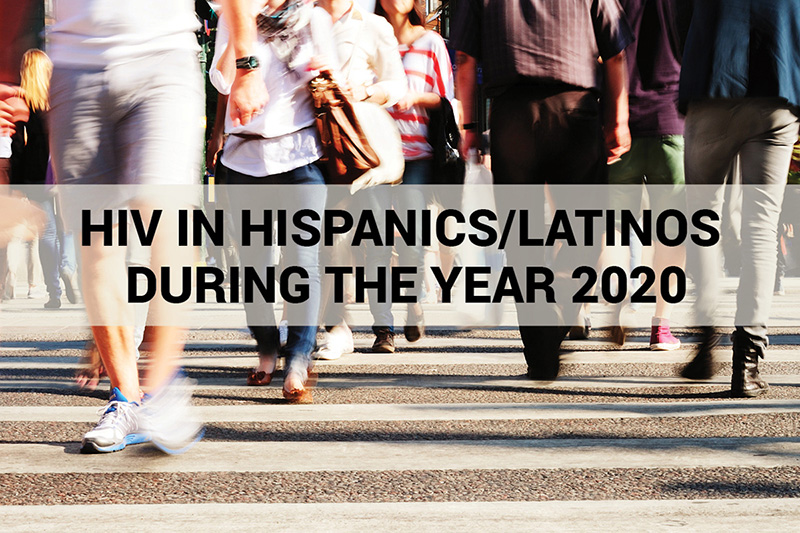Credits: this summary of the impact of HIV among Hispanics/Latinos by gender, sexual orientation and age group has been prepared by Luis A. Mares, LMSW
GENERAL
Hispanic/Latino Americans in the United States have to deal with a variety of social determinants of health that put them in a precarious position when it comes to look for and receive health services. The Latinx community deal with disproportionate poverty, a lack of education or lower levels of it, language barriers, which makes it harder to access the care and services they need.
The rate of uninsured or underinsured people is much higher among latinx than in any other community, and they may not utilize the HIV prevention and care services in their area out of fear of disclosing their immigration status.
All these factors represent the force that makes the Latinx community disproportionately affected by the HIV epidemic.
The data collected and published by the CDC through their HIV Surveillance report for the year 2020 on HIV testing, HIV care and HIV surveillance might have been affected by the COVID19 pandemic, and so this data has to be taken and interpreted cautiously.
In the USA and dependent territories there was a decrease of new HIV diagnosis from 2019 to 2020, from 36,940 to 30,635 (17% decrease). This decreased is likely to be cause partially by disruption in the clinical care service, decrease in the number of HIV testing during that period due to hesitancy to approach hiv testing sites as well as by decrease in materials for testing.
Despite this, the results showed that racial and ethnic differences persist in new HIV diagnoses. Racism, stigma, discrimination, and the barriers mention above continue to drive these disparities.
Of the 30,635 new diagnoses, 8,285 (27%) happened among Hispanics/latinx, similar to the percentage from the year 2020. We Latinos only represent 18% of the US population. The decrease in the number of diagnoses happened among Latinos as well, but the proportion of Latinos among the total number of new diagnoses continue to increase year after year.
The data published by the CDC on prevalence of HIV (People living with HIV in the US and dependent territories), showed that 24% of all PLWH are Hispanics/Latinx.
Among all the men aged 13 and older in the United States diagnosed with HIV 26% were Latinos, and among all the women aged 13 and over diagnosed with HIV 20% were Latinas.
MSM
On 2020, MSM accounted for 71% of the 30,692 new HIV diagnoses in the United States and dependent areas, accounting for 21,791 cases. Many Black/African American and Hispanic/Latino MSM with HIV, particularly young MSM, are unaware of their HIV infection. Lack of awareness of HIV status among young MSM may be due to recent infection, not being tested due to underestimation of personal risk, or fewer opportunities to be tested. Persons who do not know they have HIV do not get medical care or receive treatment and can unknowingly infect others.
During 2020, of the 21, 791 new diagnoses among MSM, 31% (6,755) happened among Latinos MSM.
From all the new HIV diagnoses among MSM aged 13 to 24 years old, 27% were among Latinos, and 32% were Latinos in the age group of 24 years and older.
Latinos represent the most impacted group by HIV in the West region (2,199 out of 4,702: 47%) and in the dependent areas (183 out of 185: 99%). Latinos also represented the second most affected group in the South, which continues to be the most affected region by HIV (2,642 out of 10,421: 25%).
The prevalence of HIV during 2020 among Latinos MSM was 26%.
TRANSGENDER PERSONS
The disparity among Transgender persons is even higher, Transgender Latinx represent 31% of the total new HIV diagnoses among Transgender persons.
Of all the Transgender Women diagnosed with HIV during 2020 (640), Latinx Transgender women represented 32%, coming on second place after the Black/African American group.
Of all the Transgender Men diagnosed with HIV during 2020 (40), the Latinx represented 25%.
The main risk factor of transmission among MSM and Transgender persons continue to be sexual contact.
WOMEN
The female population in the U.S. is estimated at 141’849,607. Of this number, 17% are Latinas. During the year 2020 there were 5,499 new HIV diagnoses among women, and of these 17% happened among Latinas.
The main risk factor among Latinas was heterosexual contact (85%).
YOUTH
Among the age group between the ages of 13 and 24, there were 6,135 new HIV diagnoses, and of these, 26% (1,519) happened among Latinx.
These new diagnoses happened mostly among MSM and the most common risk factor was sexual contact.
CHILDREN YOUNGER THAN 13 YEARS
Hispanic/Latinx children made up 26% of the total Children population in the U.S. but represented 16% of the new HIV diagnoses among children, while the prevalence in this group was 13%.


